
10 Must-See Waterfalls on Iceland’s Ring Road
Looking for Iceland’s most unforgettable waterfalls? These 10 stops along the Ring Road combine jaw-dropping scenery with easy access for every kind of road trip.
Some of Iceland’s best waterfalls are just minutes off the Ring Road. This guide shares ten of the most spectacular – and easiest to visit. That means you can see some of the country’s most powerful, photogenic, and unique waterfalls without needing to venture deep into the Highlands or tackle difficult gravel roads.
This guide highlights ten unforgettable waterfalls you can easily visit during a road trip on Iceland’s Ring Road. Whether you’re spending a week circling the country or just driving a section of Route 1, these are the stops worth planning around.
Waterfalls on Iceland’s Ring Road
The best waterfalls near Iceland’s Ring Road include Seljalandsfoss, Skógafoss, Goðafoss, and Dettifoss – all easily accessible in a campervan. Here’s the full list:
Seljalandsfoss
There’s no better way to kick off your waterfall tour than with Seljalandsfoss. Just off the Ring Road in South Iceland, this tall, narrow cascade tumbles over a cliff into a shallow pool – and uniquely, you can walk behind the curtain of water for a completely different perspective. The path circles all the way around the fall, making it one of the most interactive waterfall experiences in the country.
Be warned: you’ll get wet. Even in summer, a rain jacket is essential. It’s also one of the first major sights heading east from Reykjavík, so expect crowds unless you visit early or late in the day.
Parking fee of 1,000 ISK (~$7.13 USD / €6.82): Seljalandsfoss has long charged for parking. However, there are clean restrooms, a café, and a souvenir shop. Pay via the website Checkit.is.
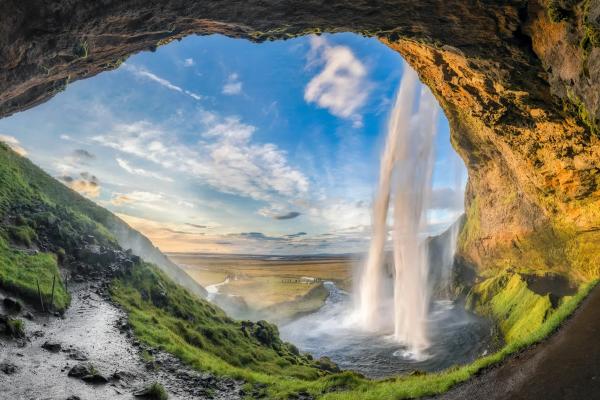
Gljúfrabúi
Just a short walk north from Seljalandsfoss lies another stunning waterfall that’s worth the extra detour – especially since parking at Seljalandsfoss now covers both. Gljúfrabúi, meaning “Canyon Dweller,” is half-concealed behind a mossy cliff face, with a narrow opening leading into the gorge. Step carefully along the stones in the stream and you’ll find yourself in a secret cavern, where the waterfall thunders into a sheltered pool.
This waterfall is much quieter than its neighbor, especially if you arrive early. Despite being so close to a major stop, many travelers miss it entirely.
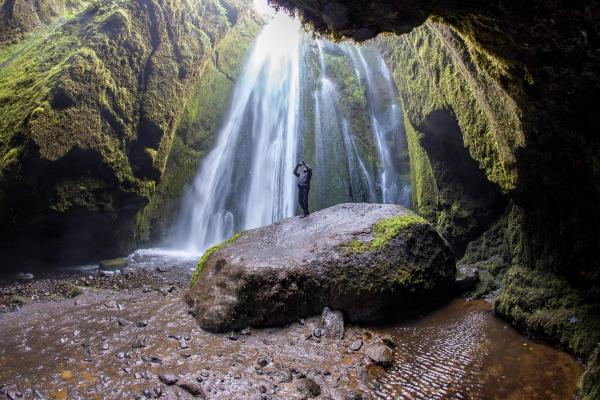
Skógafoss
Continue along the South Coast and you’ll soon arrive at Skógafoss, one of the most iconic waterfalls in Iceland. This is the one you’ve probably seen a dozen times—on postcards, in guidebooks, on Instagram: a wide, roaring curtain of water that drops nearly 60 meters straight off the cliffs above. On sunny days, rainbows form in the mist at its base.
It’s just steps from the Ring Road, with plenty of parking and basic facilities (for a small fee). If you’re feeling energetic, climb the staircase to the top of the falls for sweeping views over the coastline – and keep going along the trail for dozens more waterfalls tucked into the upper valley on the way toward the mountain pass above (the Fimmvörðuháls Pass).

Kvernufoss
While everyone’s at Skógafoss, take the time to visit its lesser-known neighbor. Kvernufoss is only a 10-minute walk from the Skógar Museum but sees far fewer visitors. The trail leads through a small gorge to a graceful waterfall spilling from a mossy cliff.
Like Seljalandsfoss, you can walk behind the cascade, but here you’ll likely have the entire place to yourself. It’s a short, easy walk and a fantastic reward for those who look beyond the obvious stops.
Parking fee of 1,000 ISK: The museum parking lot now charges a fee, payable via the Parka app.
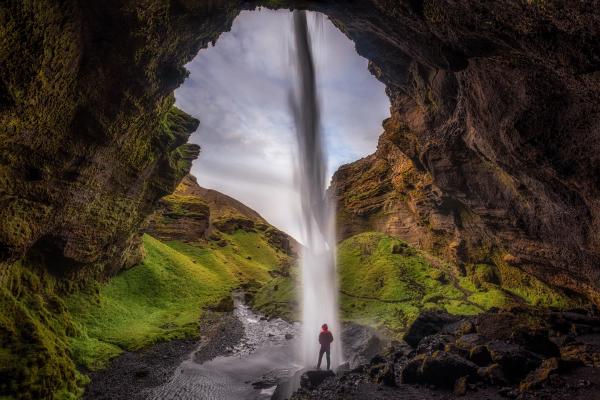
Svartifoss
Located in Skaftafell, part of Vatnajökull National Park, Svartifoss is framed by dark hexagonal basalt columns that give it a unique geometric look. It’s about a 45-minute round-trip hike from the visitor center, with a steady incline and well-marked trails.
Along the route, you’ll pass a few smaller cascades before reaching the main attraction – an elegant waterfall that’s a favorite among photographers. It’s not visible from the road, but worth the walk.
Parking fee of 1,000 ISK: Pay at the Skaftafell Visitor Center before starting your hike.
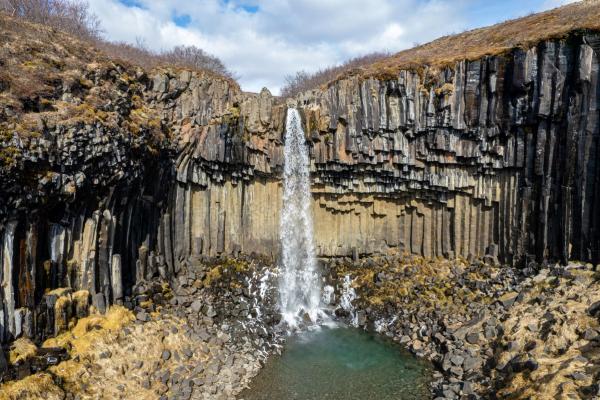
Hengifoss
In East Iceland, Hengifoss stands out not just for its height – at 128 meters, it’s one of the tallest waterfalls in the country – but also for the striking red clay and basalt layers that stripe the cliff behind it. The hike to reach it is about an hour round-trip and moderately steep, but you’ll also pass the beautiful Litlanesfoss along the way, framed by tall basalt columns.
This area of Iceland sees fewer visitors, so even in summer, the trail is often quiet. Park at the signed lot just off Route 1 outside of Egilsstaðir and be prepared for changing weather – the higher elevation means it can be windy and chilly, even in warmer months.
Parking fee of 1000 ISK: One of the more recent waterfalls to charge for parking – you can pay at the website Checkit.is.
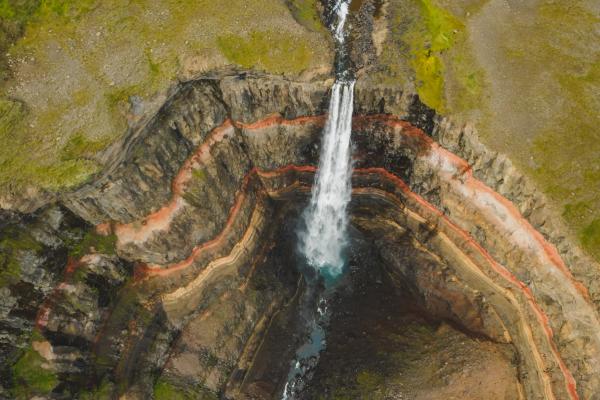
Dettifoss
Dettifoss is raw power in waterfall form. Located in North Iceland within the boundaries of Vatnajökull National Park, it’s widely regarded as the most powerful waterfall in Europe. The amount of water crashing over the edge is staggering, and the surrounding landscape – a barren, rocky canyon – only adds to its impact.
There are two access points for this Icelandic waterfall: the west side has a paved road and better facilities, while the east side is wilder and more dramatic but only reachable via gravel roads. Either way, prepare to get soaked from the spray and stay behind the ropes – this is not a place to wander too close to the edge.

Goðafoss
Between Lake Mývatn and Akureyri lies Goðafoss, “the Waterfall of the Gods.” It’s not the biggest in Iceland, but its elegant horseshoe shape and historical significance make it one of the most rewarding stops between Mývatn and Akureyri.
Legend has it that a local chieftain threw his pagan idols into the falls after Iceland converted to Christianity around 1000 AD. Today, it’s one of the most photogenic stops on the Ring Road, with easy access from both sides of the river and several viewpoints to explore. It’s also one of the few major waterfalls that’s beautiful in every season, especially under a fresh blanket of snow.

Kolugljúfur
Tucked away in a narrow gorge just north of the Ring Road in northwest Iceland, Kolugljúfur is one of the few places in Iceland that still feels like a secret. Here, the Víðidalsá River plunges into a series of waterfalls as it cuts through a deep canyon, with grassy cliffs rising steeply on either side.
It’s easy to miss the turnoff, but well worth the slight detour. The main viewing area is just a short walk from the gravel parking lot, and there’s usually no one else around. It’s an atmospheric stop, especially in moody weather, and a great example of the kind of quiet magic Iceland often keeps just out of sight.
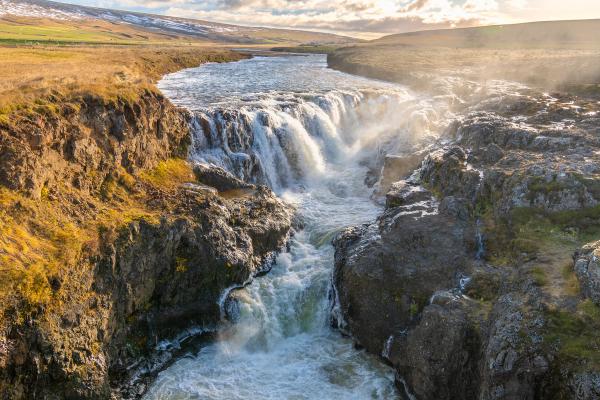
Hraunfossar
While technically in West Iceland and a short detour off the Ring Road, Hraunfossar deserves a spot on any waterfall list. Rather than plunging off a cliff, this one seeps gently from beneath a lava field, with dozens of thin streams emerging from the rock and flowing into the Hvítá River. The effect is delicate and mesmerizing.
Just upstream is Barnafossar, a churning set of rapids with its own legend. The walking paths here are excellent, and the viewing platforms are accessible for all ages. If you’re taking a day to explore inland from Borgarnes or driving toward Húsafell, don’t miss it.

Practical Tips for Visiting Iceland’s Waterfalls
Most waterfalls in Iceland are free to visit, but that doesn’t mean you can just pull up anywhere. Here are a few simple tips to make your trip smoother and safer.
- Pack a rain jacket and quick-dry layers – many of the waterfalls kick up a heavy mist, especially Seljalandsfoss, Skógafoss, and Dettifoss. Waterproof shoes or hiking boots also make a big difference on the often-muddy trails.
- Respect signs and rope barriers. These aren’t just for decoration – they’re there to keep you safe and to protect fragile vegetation. Iceland’s moss takes decades to recover from even a single footprint.
- Parking is usually straightforward, with most waterfalls having designated lots or pull-offs. Some now charge a small parking fee (like Seljalandsfoss, Kvernufoss, and soon Skógafoss as well), so keep a credit card handy, or download the Parka app. In summer, spaces can fill up quickly at the more popular stops.
- Visit early or late for better light and fewer people. Summer evenings are especially rewarding and arriving earlier or later often means better light conditions for photography.
- You’re not allowed to camp overnight in waterfall parking lots, other than the one at Skógafoss, which doubles as the local campsite.
Waterfalls on the Ring Road
There’s a reason so many travelers come to Iceland for the waterfalls alone. Few places in the world offer this kind of variety – thundering walls of water, delicate cascades, and otherworldly settings, all within reach of the main road. Whether you're snapping a photo from the car park or hiking behind a sheet of water crashing into a canyon, these waterfalls make the perfect stops to break up the drive and remind you why you came.
